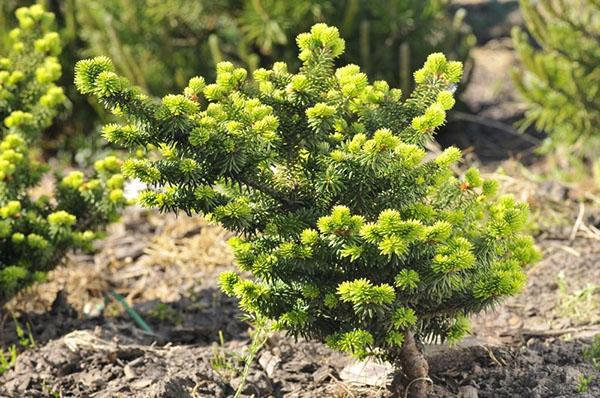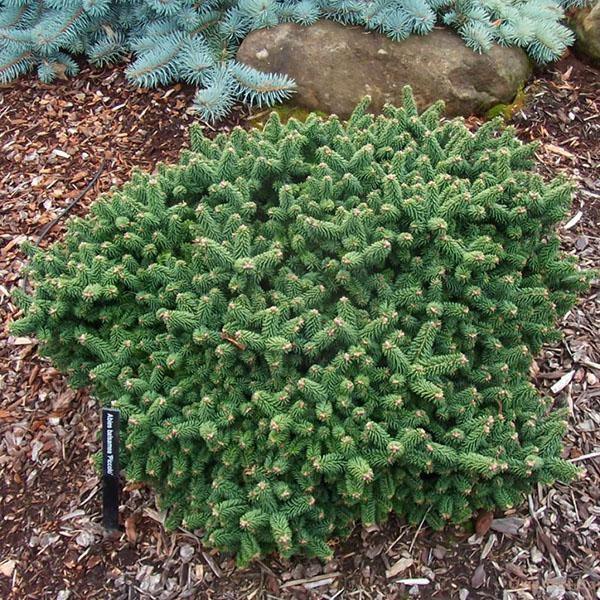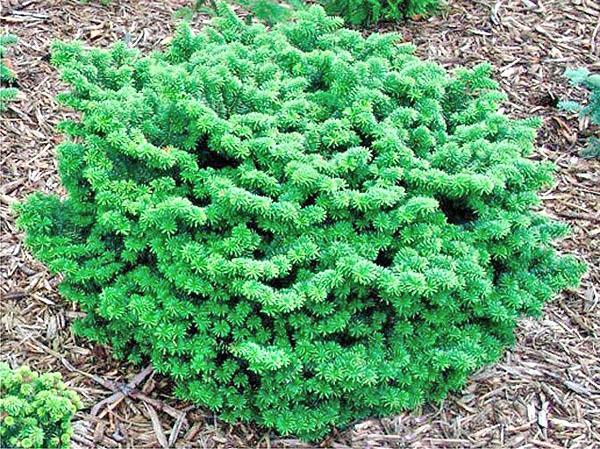Easy planting and caring for balsam fir
 Planting and caring for balsam fir is quite simple. If you follow the rules of watering and fertilizing, the tree will certainly delight both professionals and novice gardeners with its beautiful appearance.
Planting and caring for balsam fir is quite simple. If you follow the rules of watering and fertilizing, the tree will certainly delight both professionals and novice gardeners with its beautiful appearance.
Balsam fir: plant description

Balsam fir in Canada is not only considered a widespread ornamental tree, but is also a raw material for obtaining Canadian medicinal balsam.
In nature, balsam fir reaches a height of about 30 m. The crown of the tree has a conical shape, the branches hang down to the ground. The tree has a smooth brown bark. The needles are rounded, small. In adult plants, its length is 20-22 mm. The needles are arranged in the form of a scallop. The upper part is slightly darker than the lower one.
Cylindrical oval buds grow from 9 to 22 cm in diameter. At the beginning of formation, they have a purple hue. But over time they turn brown. The roots are located closer to the surface. The tree can live for over 200 years.
The main varieties of balsamic fir:
- Balsam fir Nana. This type of tree is rather small. Outwardly, it looks like a bush. It has a pronounced pleasant aroma, large branches, and an original color. The crown has a conical or spherical shape. Fir needles are dark green, at the bottom they are painted in a blue tint, and lighter in the middle. The Nana fir reaches a height of 70-100 cm. The tree can live for more than 300 years. It is great for growing in winter gardens, on rooftops, in greenhouses.

- Balsam fir Piccolo. This plant has the shape of a small shrub with a rounded crown. The branches are medium in size. They are abundantly covered with needles that have rounded ends. This type of fir is very popular in landscape design. In early spring, the shrub acquires a bright green hue due to the appearance of new shoots.

- Balsam fir Diamond. It is a dwarf squat plant that is compact in size. It can reach a height of 30-55 cm. Due to the cushion crown, the tree stands out effectively among other types of fir. The diamond has dense short needles. The needles are glossy, deep green with light patches. The needles are distinguished by wrapped ends. Their length ranges from 10 to 19 cm.

Balsam fir reaches its maximum height at 40 years of age.
Planting and caring for balsam fir
 Fir seedlings are planted in open ground from early spring to late autumn. Saplings can be purchased in greenhouses or grown independently. As for the soil, loamy soil is the best option.
Fir seedlings are planted in open ground from early spring to late autumn. Saplings can be purchased in greenhouses or grown independently. As for the soil, loamy soil is the best option.
 If this is not the case on the site, then it is necessary to prepare the substrate, which will need to be added to the dimple for planting. To create soil, you need to take three parts of humus, the same amount of clay, one part of sand and peat.
If this is not the case on the site, then it is necessary to prepare the substrate, which will need to be added to the dimple for planting. To create soil, you need to take three parts of humus, the same amount of clay, one part of sand and peat.
The landing site must be carefully dug up. Lay a drainage layer at the bottom of the pit. A good option is a mixture based on sawdust and crushed stone.
The size of the hole for planting a bush should be at least 50 by 50 cm. When planting, the edge of the root should be flush with the ground. Saplings over 5 years old are best accepted.
When growing several fir bushes, it should be borne in mind that there should be a distance of about 3 m between trees. This is due to the growth of the root system.
In Canada, balsam fir is considered the most popular species. Its habitat is the border with a coniferous forest.
Two years after planting the fir, you can start fertilizing it. As a top dressing, special mineral compositions intended for conifers are suitable. Fertilizers are also applied at planting to ensure rapid rooting.
 If you plan to grow fir in a pot or container, then as the tree grows, you should change the container to a larger one. Fir thrives in the shade, but loves the sun more, so an open area with good lighting is the best place to plant.
If you plan to grow fir in a pot or container, then as the tree grows, you should change the container to a larger one. Fir thrives in the shade, but loves the sun more, so an open area with good lighting is the best place to plant.
Care activities
 Fir is not a whimsical tree. It is resistant to frost and wind. Moist and cool soil will be the best place for fir trees. The soil for its full growth should be fertile, loose, with medium acidity. High air temperature, a large amount of sand in the soil are destructive for fir.
Fir is not a whimsical tree. It is resistant to frost and wind. Moist and cool soil will be the best place for fir trees. The soil for its full growth should be fertile, loose, with medium acidity. High air temperature, a large amount of sand in the soil are destructive for fir.
Watering
If it rains regularly in your area, then you do not need to water the trees. Otherwise, the fir should be irrigated regularly. Two times a week, settled water will suffice. Compacted soil can negatively affect plant development. Therefore, you should regularly dig up the soil around the plants so that it becomes loose. The soil is recommended periodically mulch peat or sawdust.
Do not dig in close to the trunk so as not to touch the roots.
Fir formation
 Fir has very strong branches, but if a lot of snow falls, then under its weight they can bend and break. Therefore, it is very important to install supports. It is better not to plant a fir in conditions of polluted air, since it is destructive for it. It is best to place the tree outside the city, where the climate is cleaner.
Fir has very strong branches, but if a lot of snow falls, then under its weight they can bend and break. Therefore, it is very important to install supports. It is better not to plant a fir in conditions of polluted air, since it is destructive for it. It is best to place the tree outside the city, where the climate is cleaner.
In most varieties, the crown of the tree is formed by itself; you do not need to cut branches to shape it. To create a crown, only the central shoots of the lateral branches are removed. A similar procedure is carried out in the autumn period of the year, when the sap flow stops.
During the winter months, when there is severe frost, small fir trees should be covered.
Pests and diseases
The plant is quite resistant to various ailments. Rare watering or negative weather changes can weaken the immune system. These factors provoke the spruce-fir hermes in the plant. The disease manifests itself in the lightening of the color of the needles. In addition, the appearance of white dots and black insects on the needles is a sign of the disease. Fir is susceptible to disease in the spring. If you notice signs of an illness, you should treat the plant with insecticides that have a complex effect.
Balsam fir in landscape design
 Balsam fir is a common element of landscape design. Used in the formation of alleys, to create hedges. Fir has external grace and attractiveness, so it stands out favorably in a variety of compositions.
Balsam fir is a common element of landscape design. Used in the formation of alleys, to create hedges. Fir has external grace and attractiveness, so it stands out favorably in a variety of compositions.  Self-growth also looks beautiful. The shrub looks great both in large and small areas and dachas. When creating a site in the Art Nouveau, Japanese style, you can safely use fir.
Self-growth also looks beautiful. The shrub looks great both in large and small areas and dachas. When creating a site in the Art Nouveau, Japanese style, you can safely use fir.  In the garden of coniferous plants, it will take its place of honor. Balsamic fir looks beautiful on alpine hills, rockeries, heather garden.
In the garden of coniferous plants, it will take its place of honor. Balsamic fir looks beautiful on alpine hills, rockeries, heather garden.
In the wild, the tree lives along the banks. Therefore, in personal plots, you can safely plant it near water bodies.  When decorating a personal plot by planting fir, you should pay attention to the fact that balsamic fir varieties Nana and Hudsonia are most suitable for these purposes.
When decorating a personal plot by planting fir, you should pay attention to the fact that balsamic fir varieties Nana and Hudsonia are most suitable for these purposes.